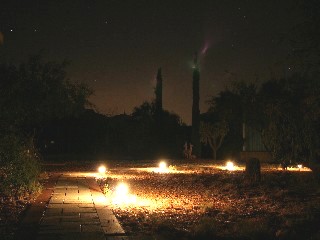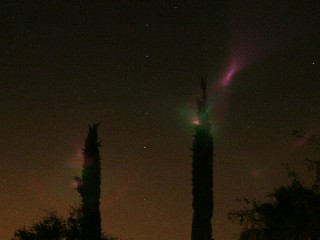| PAST |
June 21, 2006 |
NEXT |
|
Graphical Wednesday |
 |
 |
| * Night Shots * |
I had some pretty neat results on the first night I played with my new camera. One such incident here was when I was playing with the longer shutter speed for night shots without a flash. You can clearly see the lights on the walkway here next to my house. But you can also see the glow in the sky to the south from the city of Tucson. In the full-size image you can clearly see more stars. But the strangest thing that happened was this colorful lens flare from the glare of the lights that seemed to just stick to the tall cedar trees there.
That night I had also pointed my camera to the north sky and to the big dipper. I took several pictures with a shutter speed of about 30 seconds. (The max automatic setting on the camera). I did actually capture all the stars of the dipper and many in the background as well. But after I was panning around the image I noticed that the dipper stars and many others were a little blurred. But I panned to the north star and found that it was solid. Then after a little more investigation I discovered that I had actually captured the rotation of the earth and the stars were not blurred, but just slightly streaked in the sky. So it wasn't the camera that moved, and it wasn't the stars that moved. It was the planet.
So I spent all this time and money and bought this fancy new camera. Now how am I going to be able to take a good picture if I can't even get the planet to stay still long enough to take a good photo? (hee hee)
On a final note for today's posting, I did have to take my fancy camera back to the store and get a replacement. While playing with taking pictures of the night sky I did find a flaw in the camera. While panning around a different image where all the stars were really blurred, I found one in every shot that was solid. Then I noticed that it was always in the same place on every image. It was even on every other image I had taken. So I discovered that the camera actually had a bad pixel in the CCD (Charge-Coupled Device). With an eight megapixel CCD, it had one bad pixel out of almost eight million. Now that's not that big of a deal, and the spot was hardly noticeable unless you really zoomed in. But after I found it, I saw it every time and it just bugged me too much. So I had to replace the camera.
Something to consider when buying any new digital camera is to check for flaws like these that might get past the factory inspections. A good way to do this is to take a totally dark image, possibly with the lens cap on. Of course you might end up accidentally taking a few of these anyway. (ha ha). But then zoom in and pan around the image completely to make sure that there are no little variations or spots. They will be very tiny, so you have to be very thorough. If you see any then there are likely some bad or defective pixels.